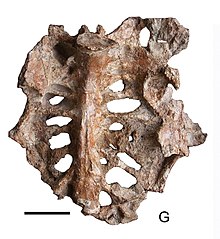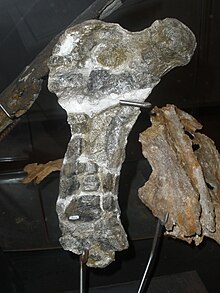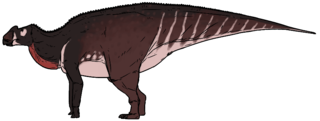
Aralosaurus was a genus of hadrosaurid dinosaur that lived during the Late Cretaceous in what is now Kazakhstan. It is known only by a posterior half of a skull and some post-cranial bones found in the Bostobe Formation in rocks dated from the Upper Santonian-Lower Campanian boundary, at about 83.6 Ma. Only one species is known, Aralosaurus tuberiferus, described by Anatoly Konstantinovich Rozhdestvensky in 1968. The genus name means Aral Sea lizard, because it was found to the northeast of the Aral Sea. The specific epithet tuberiferus means bearing a tuber because the posterior part of the nasal bone rises sharply in front of the orbits like an outgrowth. Aralosaurus was originally reconstituted with a nasal arch similar to that of North American Kritosaurus. For many years, Aralosaurus was thus placed in the clade of the Hadrosaurinae. This classification was invalidated in 2004, following the re-examination of the skull of the animal which allowed to identify in Aralosaurus many typical characters of Lambeosaurinae. In particular, this study revealed that Aralosaurus had a hollow bony structure located far in front of the orbits, which communicated with the respiratory tract. This structure being broken at its base, its shape and size remains undetermined. More recently, Aralosaurus has been identified as the most basal Lambeosaurinae, and placed with its close relative Canardia from the upper Maastrichtian of France in the new clade of Aralosaurini.

Rhabdodon is a genus of ornithopod dinosaur that lived in Europe approximately 70-66 million years ago in the Late Cretaceous. It is similar in build to a very robust "hypsilophodont", though all modern phylogenetic analyses find this to be an unnatural grouping, and Rhabdodon to be a basal member of Iguanodontia. It was large amongst its relatives, measuring 4 m (13 ft) long and weighing 250 kg (550 lb), with some specimens possibly reaching up to 6 m (20 ft) long.

Tarascosaurus is a genus of abelisaurid theropod dinosaur from Late Cretaceous of France. It was a relatively small theropod measuring 2.5–3 metres (8.2–9.8 ft) long.

Ampelosaurus is a titanosaurian sauropod dinosaur from the Late Cretaceous Period of what is now France. Its type species is A. atacis, named by Le Loeuff in 1995. Its remains were found in a level dating from 71.5 million years ago representing the early Maastrichtian.

Betasuchus is a genus of theropod dinosaur which lived during the Late Cretaceous Period. Betasuchus is, besides Orthomerus, the only dinosaur genus named from remains found in the Netherlands and the only non-avian theropod found in the Maastrichtian Beds.

Bradycneme is a genus of theropod dinosaur from the Maastrichtian-age Upper Cretaceous Sânpetru Formation of the Hațeg Basin, Transylvania, Romania. The genus contains a single species, Bradycneme draculae, known only from a partial right lower leg, which its original describers believed came from a giant owl.

Elopteryx is a genus of, perhaps troodontid, maniraptoran theropod dinosaur based on fragmentary fossils found in late Cretaceous Period rocks of Romania. The single species, Elopteryx nopcsai, is known only from very incomplete material, and therefore is considered a nomen dubium by most paleontologists.

Variraptor is a genus of dromaeosaurid theropod dinosaur from the Late Cretaceous of France.
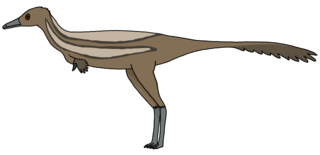
Heptasteornis is the name given to a potentially dubious genus of alvarezsaurid dinosaur from the Late Cretaceous. The type species is Heptasteornis andrewsi, described as a presumed gigantic prehistoric owl in 1975. It was previously included in Elopteryx nopcsai and indeed the holotypes of both were believed to be from the same individual as they were discovered, and initially were assigned the same specimen number. This appears to be in error however.

Allodaposuchus is an extinct genus of crocodyliforms that lived in what is now southern Europe during the Campanian and Maastrichtian stages of the Late Cretaceous. Although generally classified as a non-crocodylian eusuchian crocodylomorph, it is sometimes placed as one of the earliest true crocodylians. Allodaposuchus is one of the most common Late Cretaceous crocodylomorphs from Europe, with fossils known from Romania, Spain, and France.

Hatzegopteryx is a genus of azhdarchid pterosaur found in the late Maastrichtian deposits of the Densuş Ciula Formation, an outcropping in Transylvania, Romania. It is known only from the type species, Hatzegopteryx thambema, named by Buffetaut et al. in 2002 based on parts of the skull and humerus. Additional specimens, including a neck vertebra, were later placed in the genus, representing a range of sizes. The largest of these remains indicate it was among the biggest pterosaurs, with an estimated wingspan of 10 to 12 metres.
Argiles et Grès à Reptiles Formation also known as the Argiles Rutilantes Formation is an early Maastrichtian French geologic formation in the département of Var preserving the remains of several types of dinosaurs and other extinct organisms.

Axelrodichthys is an extinct genus of mawsoniid coelacanth from the Cretaceous of Africa, North and South America, and Europe. Several species are known, the remains of which were discovered in the Lower Cretaceous (Aptian-Albian) of Brazil, North Africa, and possibly Mexico, as well as in the Upper Cretaceous of Morocco (Cenomanian), Madagascar and France. The Axelrodichthys of the Lower Cretaceous frequented both brackish and coastal marine waters while the most recent species lived exclusively in fresh waters. The French specimens are the last known fresh water coelacanths. Most of the species of this genus reached 1 metre to 2 metres in length. Axelrodichthys was named in 1986 by John G. Maisey in honor of the American ichthyologist Herbert R. Axelrod.

Mawsoniidae is an extinct family of prehistoric coelacanth fishes which lived during the Triassic to Cretaceous periods. Members of the family are distinguished from their sister group, the Latimeriidae by the presence of ossified ribs, a coarse rugose texture on the dermatocranium and cheek bones, the absence of the suboperculum and the spiracular, and reduction or loss of the descending process of the supratemporal. Mawsoniids are known from North America, Europe, South America, Africa, Madagascar and Asia. Unlike Latimeriidae, which are exclusively marine, Mawsoniidae were also native to freshwater and brackish environments. Mawsoniids represent among the youngest known coelacanths, with the youngest known remains of the freshwater genus Axelrodichthys from France and an indeterminate marine species from Morocco being from the final stage of the Cretaceous, the Maastrichtian, roughly equivalent in age to the youngest known fossils of latimeriids. Species of Mawsonia and Trachymetopon are known to have exceeded 5 metres in length, making them among the largest known bony fish to have ever existed.

Musturzabalsuchus is an extinct monospecific genus of allodaposuchid eusuchian crocodyliform. The type and only species is Musturzabalsuchus buffetauti.
The Marnes d’Auzas Formation is a geological Formation in southwestern France whose strata date back to the Late Maastrichtian. It is about 100 metres thick and consists primarily of marls with some interbeds of sandstones. It corresponds to sediments whose depositional environment evolved from the paralic domain at the base of the formation, towards a more continental domain in its upper part. The Marnes d’Auzas Formation was deposited in the west coast of the former Ibero-Armorican Island, which included much of France and Spain.
The Marnes Rouges Inférieures Formation is a Late Cretaceous geologic formation found in the French Pyrenees. It predominantly consists of red mustone, with minor brown mudstone and sandstone. Dinosaurs, dinosaur eggs and avialian stem-birds have been reported from the formation.

The Sânpetru Formation is an early Maastrichtian geologic formation. Dinosaur remains are among the fossils that have been recovered from the formation. It is located in Romania, near Sânpetru village, part of Sântămăria-Orlea commune. It forms a component of the Hațeg Island fauna.
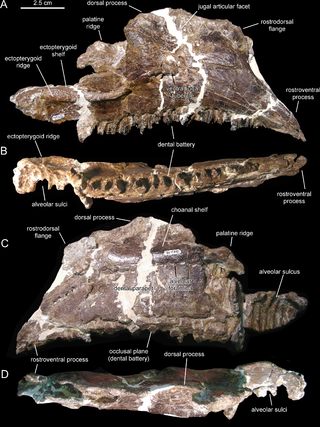
Canardia is an extinct genus of lambeosaurine dinosaur known from the Late Cretaceous Marnes d'Auzas Formation of Haute-Garonne department, in Occitanie region, southwestern France. The type species Canardia garonnensis was first described and named by Albert Prieto-Márquez, Fabio M. Dalla Vecchia, Rodrigo Gaete and Àngel Galobart in 2013. It is only known from juvenile specimens. The name of the genus comes from “canard”, the French word for “duck”, an allusion to the fact that this animal belongs to the hadrosaurids which are also known as duck-billed dinosaurs. The specific epithet garonnensis refers to the Haute-Garonne department where this dinosaur has been found. Although universally recognized as a lambeosaurine, its precise position within them is debated. Some authors consider it as a close relative of the genus Aralosaurus from Central Asia with which it would form the tribe Aralosaurini, while others include it in a more derived clade, the Arenysaurini in which all lambeosaurines from Europe and North Africa are placed. Canardia was one of the last non-avian dinosaurs and lived between 67,5 and 66 my on the former Ibero-Armorican Island, which included much of France and Spain.

Abditosaurus is an extinct genus of titanosaurian sauropod dinosaur from the Late Cretaceous (Maastrichtian) Tremp Group of Catalonia, Spain. The type and only species is Abditosaurus kuehnei. Phylogenetic analyses recover it within a clade of South American and African saltasaurines, distinct from other insular dwarf sauropods from the European archipelago. Abditosaurus inhabited the Ibero-Armorican Island, a prehistoric island made up of what is now Spain, Portugal, and southern France, and would have been the largest titanosaur species in its environment.
